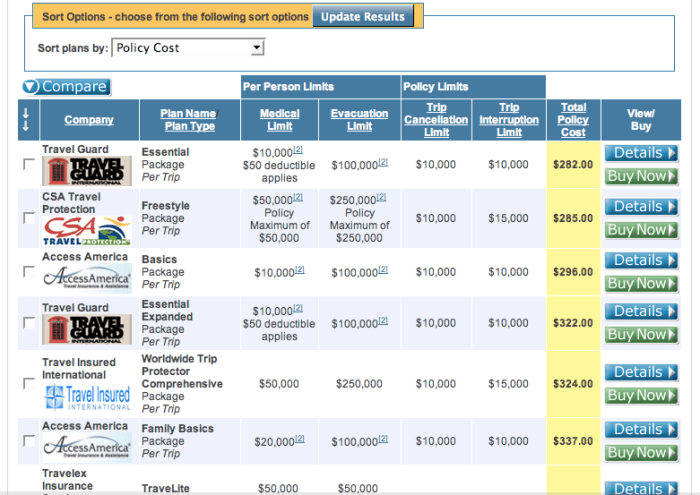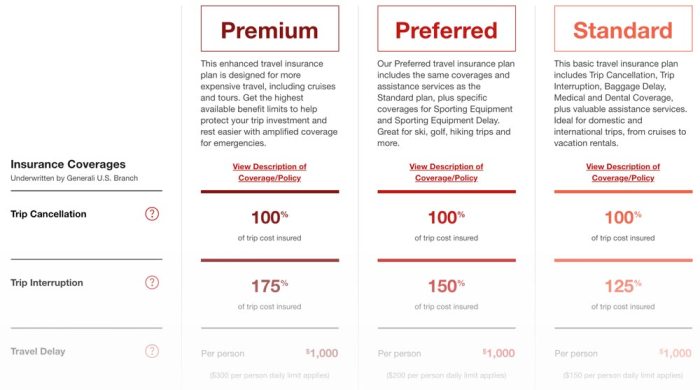
Planning a trip is exciting, filled with dreams of exotic locales and unforgettable experiences. But what about the unexpected? A sudden illness, a flight cancellation, or lost luggage can quickly turn a dream vacation into a financial nightmare. This is where trip insurance steps in, offering a crucial safety net. Understanding the nuances of different trip insurance policies, however, can be daunting. This comprehensive guide navigates the complexities of trip insurance comparison, empowering you to make informed decisions and protect your investment.
We’ll delve into various policy types, key factors influencing costs, crucial coverage options, and the claims process. By the end, you’ll be equipped to compare different providers, identify the best fit for your travel style and budget, and embark on your journey with peace of mind, knowing you’re well-protected.
Understanding Trip Insurance Types

Choosing the right trip insurance can feel overwhelming, given the variety of options available. Understanding the different types and their coverage is crucial to ensuring you’re adequately protected during your travels. This section will clarify the key differences between common trip insurance plans, allowing you to make an informed decision based on your specific needs and travel style.
Trip Insurance Categories
Trip insurance policies are categorized based on the duration of coverage and the scope of protection offered. The most common types include single-trip insurance, annual multi-trip insurance, and comprehensive plans. These categories differ significantly in terms of cost, coverage periods, and the types of events they cover. Careful consideration of your travel plans is necessary to select the most suitable option.
Comparison of Three Major Trip Insurance Types
Let’s compare three prevalent types: Single-Trip, Annual Multi-Trip, and Comprehensive plans. Each offers a distinct set of benefits and limitations, catering to different travel patterns and risk tolerances. Understanding these differences is vital for choosing the right level of protection.
| Feature | Single-Trip Insurance | Annual Multi-Trip Insurance | Comprehensive Insurance |
|---|---|---|---|
| Coverage Period | Covers a single trip, typically from a few days to several weeks. | Covers multiple trips within a year, usually with a maximum trip duration per trip. | Covers a single trip, but often includes broader coverage than basic single-trip plans. |
| Cost | Generally less expensive per trip. | More expensive upfront, but potentially cost-effective for frequent travelers. | More expensive than basic single-trip plans, reflecting the broader coverage. |
| Coverage Examples | Trip cancellation/interruption, medical emergencies, lost baggage. | Trip cancellation/interruption, medical emergencies, lost baggage (for each trip). | Trip cancellation/interruption, medical emergencies, lost baggage, additional coverage like rental car damage, or emergency evacuation. |
| Limitations | Only covers one trip; coverage may be limited depending on the plan. | Limited coverage per trip; may exclude certain activities or destinations. | Higher premium; specific exclusions may apply, depending on the policy details. |
Understanding Coverage Features
Each trip insurance type provides varying levels of protection against unforeseen circumstances. For instance, a single-trip policy might cover trip cancellation due to illness, while an annual multi-trip policy would offer the same coverage for multiple trips within a year, subject to the policy’s terms. Comprehensive plans typically extend coverage to a wider range of situations, often incorporating additional benefits like emergency medical evacuation or coverage for lost or stolen belongings. Consider your individual needs and travel habits when assessing the necessity of these added benefits.
Key Factors Influencing Trip Insurance Costs

Several interconnected factors determine the price of travel insurance. Understanding these elements allows travelers to make informed decisions and find the most suitable and affordable coverage. The cost isn’t simply a fixed amount; it’s a dynamic calculation based on your specific trip details and personal circumstances.
Trip insurance premiums are calculated using a complex algorithm considering various risk factors. These factors interact, meaning a change in one area can significantly impact the overall cost, sometimes unexpectedly. For example, a seemingly minor change like extending your trip by a week could lead to a substantial premium increase, especially if the destination is known for higher medical costs or has a greater risk of natural disasters.
Trip Length
Longer trips generally mean higher premiums. Insurers assess risk over a longer period, increasing the potential for unforeseen events requiring coverage. For instance, a 10-day trip to Europe will likely cost less than a 30-day backpacking adventure across Southeast Asia. The increased duration raises the probability of needing medical assistance, baggage loss, or trip cancellations due to unforeseen circumstances.
Destination
The location of your trip significantly impacts the cost. Destinations with higher incidences of medical emergencies, political instability, or natural disasters will command higher premiums. A trip to a remote trekking location in Nepal, for example, carries a greater risk than a stay in a major European city, resulting in a higher insurance cost. The cost of medical evacuation from remote areas also contributes significantly to the premium.
Traveler’s Age
Age is a key factor because the likelihood of needing medical attention generally increases with age. Older travelers may face higher premiums due to a statistically increased risk of health issues requiring medical care during their travels. This is a common actuarial practice across many insurance sectors, not just travel insurance.
Pre-existing Conditions
Pre-existing medical conditions significantly influence the cost, sometimes leading to higher premiums or even the inability to obtain certain types of coverage. Insurers carefully assess the nature and severity of these conditions to determine the level of risk. For example, a traveler with a history of heart problems might face higher premiums or be required to provide additional medical documentation. In some cases, specific pre-existing conditions might not be covered at all, depending on the policy.
Hypothetical Scenario: Trip Length and Premium
Let’s consider a hypothetical scenario: A 35-year-old individual plans a trip to Paris. Initially, they plan a 7-day trip, and the insurance quote is $100. If they extend the trip to 14 days, keeping all other factors constant, the premium might increase to $175, reflecting the increased risk associated with a longer duration. This increase highlights the significant impact trip length can have on the overall cost. This is a simplified example, and the actual increase could vary based on other factors and the specific insurance provider.
Comparing Coverage Options and Exclusions

Choosing the right trip insurance policy involves carefully comparing the coverage options offered by different providers and understanding their exclusions. This ensures you have the appropriate protection for your specific travel needs and avoids unpleasant surprises should an unforeseen event occur. A thorough comparison is crucial to make an informed decision.
Common Coverage Options and Variations
Trip insurance policies typically offer a range of coverage options, though the specifics and limits can vary significantly between insurers. Three key areas of coverage are medical expenses, trip cancellations, and baggage loss. Understanding these variations is vital for selecting a policy that aligns with your risk tolerance and the potential costs associated with your trip.
- Medical Expenses: This covers medical treatment, hospitalization, and emergency medical evacuation while traveling. Coverage limits vary widely, from a few thousand dollars to hundreds of thousands. Some policies may include coverage for pre-existing conditions, subject to specific limitations and notification requirements. Others might offer repatriation services to bring you home if necessary.
- Trip Cancellations: This reimburses non-refundable trip costs if you have to cancel due to covered reasons, such as illness, severe weather, or family emergencies. Policies differ in the specific events they cover and the documentation required to file a claim. Some insurers offer more comprehensive coverage for cancellation reasons than others.
- Baggage Loss: This covers the loss, theft, or damage of your checked and carry-on baggage. Coverage limits vary, and some policies may have deductibles. It’s important to check whether the policy covers delays in baggage arrival as well.
Typical Exclusions in Trip Insurance Policies
Most trip insurance policies exclude certain events or circumstances from coverage. Understanding these exclusions is just as important as understanding the coverage itself. Failing to do so could lead to unexpected financial burdens if a covered event occurs.
- Pre-existing conditions: Many policies will not cover medical expenses related to pre-existing conditions unless specific add-ons are purchased. The definition of a “pre-existing condition” and the waiting periods can also vary greatly.
- Acts of war or terrorism: These events are frequently excluded from standard trip insurance policies. Travel to high-risk areas may require specialized insurance.
- Adventure sports: Participation in high-risk activities such as extreme skiing, scuba diving, or mountain climbing may not be covered, or may require additional coverage at a higher premium.
- Intoxication or illegal activities: Claims resulting from activities under the influence of alcohol or drugs, or participation in illegal activities, are generally not covered.
Comparison of Three Insurance Providers
The following table compares coverage inclusions and exclusions for three hypothetical insurance providers – “TravelSafe,” “Globetrotter,” and “AdventureGuard.” Remember that specific policy details and pricing vary depending on the trip details and the specific policy purchased. This is for illustrative purposes only and should not be considered financial advice.
| Feature | TravelSafe | Globetrotter | AdventureGuard |
|---|---|---|---|
| Medical Expense Coverage (USD) | $100,000 | $50,000 | $250,000 |
| Trip Cancellation Coverage (USD) | $5,000 | $10,000 | $7,500 |
| Baggage Loss Coverage (USD) | $1,000 | $1,500 | $2,000 |
| Pre-existing Conditions Coverage | Limited, with add-on | None | Limited, with add-on |
| Adventure Sports Coverage | Limited, with add-on | None | Included for certain activities |
| Terrorism Coverage | Excluded | Excluded | Excluded |
Claims Process and Customer Reviews
Understanding the claims process and reviewing customer feedback are crucial steps in choosing the right trip insurance. A smooth claims process can significantly reduce stress during an unexpected event, while customer reviews offer valuable insights into a provider’s reliability and responsiveness.
The typical claims process generally involves several steps. First, you’ll need to report the covered incident to your insurance provider as soon as reasonably possible. This usually involves contacting them by phone or through their online portal. Next, you’ll need to gather all necessary documentation to support your claim. This may include medical bills, police reports, flight cancellation confirmations, and receipts for additional expenses incurred due to the covered event. Your provider will then review your claim and supporting documentation, and if everything is in order, they will process your claim and issue payment. The timeline for processing varies depending on the provider and the complexity of the claim.
Claim Scenarios: Covered and Excluded
Examples of scenarios likely covered by trip insurance include medical emergencies while traveling, trip cancellations due to unforeseen circumstances like severe weather or a family member’s illness, and lost or stolen luggage. For example, a policy might cover emergency medical evacuation if you suffer a heart attack while backpacking in a remote area. Similarly, if a hurricane forces the cancellation of your flight, resulting in missed hotel reservations and other expenses, your trip insurance might reimburse you for those losses. However, pre-existing medical conditions are often excluded unless specifically covered with additional riders purchased at the time of policy acquisition. Similarly, claims resulting from reckless behavior or failure to follow safety guidelines might not be covered. For instance, engaging in extreme sports without proper authorization or coverage, or neglecting to heed official travel advisories, could lead to a claim denial. Another common exclusion is for claims related to acts of war or terrorism, unless specific riders are purchased to cover such scenarios.
Factors to Consider When Reviewing Customer Feedback
Before purchasing trip insurance, it’s essential to carefully review customer feedback and testimonials. Consider the following factors when assessing these reviews:
When reviewing customer feedback, focus on several key aspects. Firstly, look for a consistent pattern in the types of experiences reported. Do you see overwhelmingly positive or negative feedback? Secondly, pay attention to the detail level of the reviews. Vague, generic comments are less informative than specific accounts of a provider’s handling of a claim. Thirdly, consider the timeframe of the reviews. More recent reviews are generally more relevant as they reflect the provider’s current performance. Finally, be wary of reviews that seem overly positive or negative, as these may be fake or biased. Look for a balanced range of experiences to get a more realistic picture of the provider’s performance.
- Frequency and recency of reviews: A large number of recent reviews suggests ongoing activity and provides a more current picture of customer satisfaction.
- Specificity of reviews: Detailed reviews outlining the claims process, response times, and the overall experience provide more valuable insights than general statements.
- Balance of positive and negative reviews: A mix of both positive and negative reviews indicates authenticity, whereas an overwhelmingly positive or negative response may be suspicious.
- Resolution of negative reviews: How did the provider respond to negative feedback? A prompt and effective response shows a commitment to customer service.
- Consistency of feedback across multiple platforms: Checking reviews across various websites and platforms helps verify the accuracy and reliability of the feedback.
Illustrative Examples of Trip Insurance Scenarios
Choosing the right trip insurance policy depends heavily on the specifics of your trip. Understanding different scenarios helps illustrate the importance of carefully considering your needs and risk tolerance before purchasing coverage. The examples below highlight situations where comprehensive versus less comprehensive plans are appropriate.
Comprehensive Trip Insurance: A Business Trip to a Remote Location
Imagine a scenario involving a high-stakes business trip to a remote area of the Amazon rainforest for a week. The trip involves navigating challenging terrain, potential exposure to infectious diseases, and a significant financial investment in equipment and travel arrangements. In this case, comprehensive trip insurance is highly recommended. A comprehensive policy would offer extensive medical coverage, including emergency medical evacuation (potentially a life-saving feature in a remote location), trip interruption coverage (if unforeseen circumstances prevent the completion of the business trip), baggage loss or damage coverage (to protect expensive equipment), and potentially even coverage for political instability or natural disasters that might impact the trip. The cost of such a policy might seem high, but the potential financial and personal risks are significantly higher without it. The peace of mind afforded by knowing you’re comprehensively covered far outweighs the cost in this high-risk scenario.
Less Comprehensive Trip Insurance: A Short Weekend Getaway
Conversely, consider a short weekend getaway to a nearby city for a friend’s wedding. The trip involves minimal financial investment and relatively low risk. In this scenario, a less comprehensive trip insurance policy might suffice. A basic policy covering trip cancellation due to unforeseen circumstances (like a sudden illness) and emergency medical expenses would likely be adequate. While baggage loss or damage coverage might be considered, the potential loss is significantly less than in the previous example. The emphasis here is on basic protection against unforeseen events that could disrupt the trip or lead to unexpected medical bills, without the need for extensive coverage for potentially less likely scenarios. The lower cost of a less comprehensive plan aligns well with the lower risk profile of this type of trip.
Scenario 1: Backpacking Trip Through Southeast Asia
A three-month backpacking trip through Southeast Asia presents a higher risk profile than a short weekend trip. The traveller will be in various locations, potentially encountering diverse health risks, and relying on less reliable infrastructure. A comprehensive policy is advisable, including extensive medical coverage (especially given potential exposure to unfamiliar diseases), trip interruption coverage (to account for potential travel disruptions or unforeseen events), and potentially coverage for lost or stolen belongings. The extended duration and potential for unforeseen circumstances necessitate a higher level of protection than a short domestic trip.
Scenario 2: Cruising the Caribbean
A week-long Caribbean cruise is generally considered a lower-risk trip compared to backpacking through Southeast Asia. While medical emergencies can still occur, the accessibility of medical care on a cruise ship and in Caribbean ports is typically better. A less comprehensive policy, covering trip cancellation, emergency medical expenses, and perhaps baggage loss, might be sufficient. The shorter duration and relatively predictable nature of the trip reduce the need for extensive coverage compared to a longer, more adventurous journey. The cost-benefit analysis favors a more affordable policy given the lower overall risk.
Conclusion
Choosing the right trip insurance is a vital step in ensuring a smooth and worry-free travel experience. By carefully comparing policies, understanding coverage details, and considering your individual needs and risk tolerance, you can secure the protection you deserve. Remember to read the fine print, compare quotes from multiple providers, and don’t hesitate to seek clarification on any ambiguities. With the right insurance, you can focus on creating memories instead of stressing over unforeseen circumstances. Safe travels!
FAQ Summary
What is the difference between single-trip and annual multi-trip insurance?
Single-trip insurance covers a single journey, while annual multi-trip insurance provides coverage for multiple trips within a year.
Can I claim for pre-existing medical conditions?
Coverage for pre-existing conditions varies greatly depending on the insurer and policy. Some policies offer limited coverage, while others may exclude them entirely. It’s crucial to disclose any pre-existing conditions when applying.
What happens if my flight is delayed?
Many trip insurance policies cover expenses incurred due to significant flight delays, such as accommodation and meals, but the specific coverage and conditions vary.
How long does it take to process a claim?
Claim processing times differ depending on the insurer and the complexity of the claim. Allow sufficient time for processing, often several weeks.
Are there any age restrictions for trip insurance?
Yes, some insurers may have age restrictions or higher premiums for travelers over a certain age. Check the specific policy details.